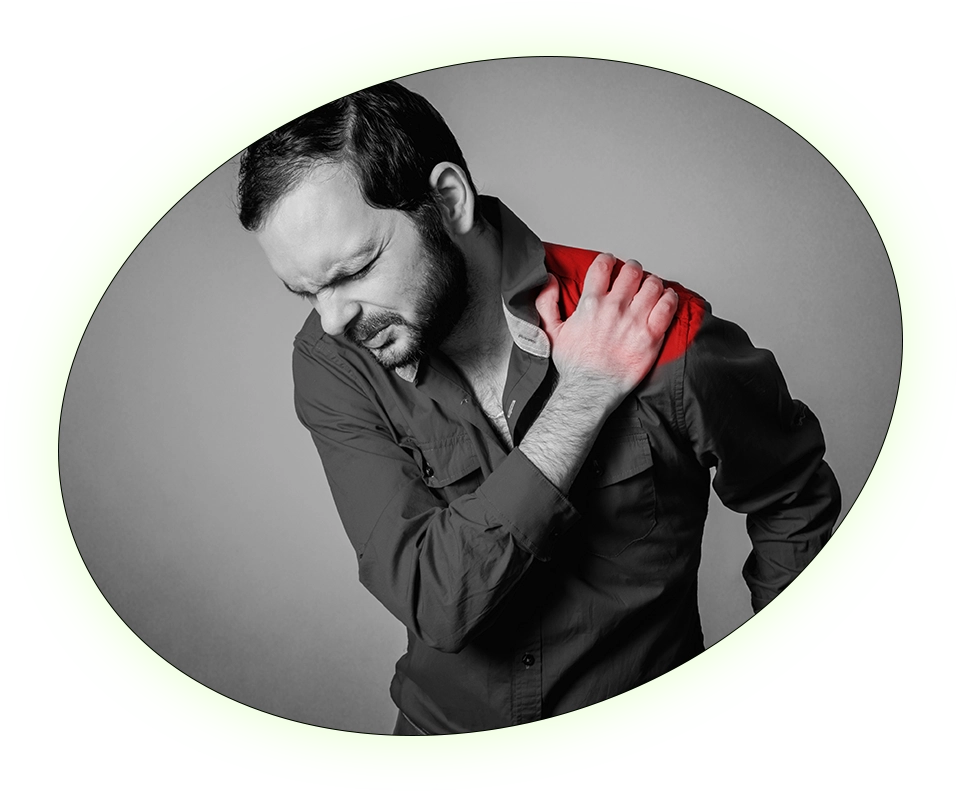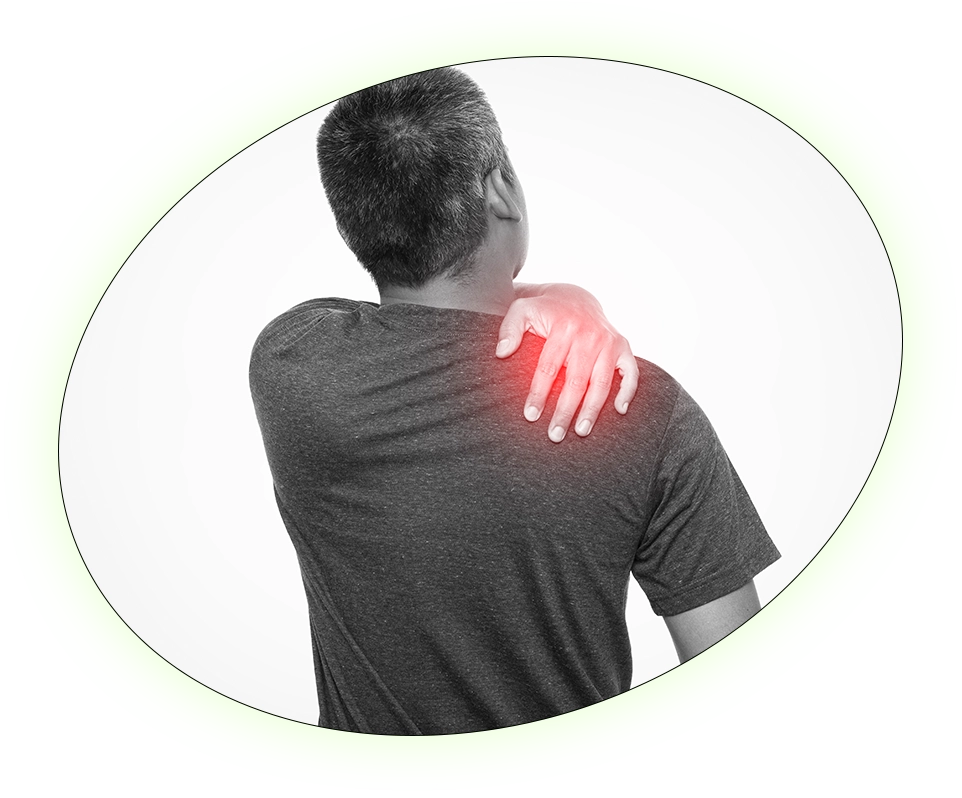Shoulder Pain
Shoulder pain is more than just discomfort—it can disrupt sleep, limit movement, and weaken your ability to perform daily tasks. Whether you’re an athlete, office worker, or someone dealing with aging joints, shoulder pain can creep in and hold you back.
Ignoring the pain or pushing through it can make things worse, leading to long-term mobility issues and chronic discomfort. Understanding its root cause is the key to regaining function and preventing long-term damage.

Shoulder pain can result from a sudden injury, repetitive strain, nerve compression, or chronic conditions.
Shoulder pain can result from overuse and repetitive motion, such as sports, weightlifting, or prolonged desk work, leading to strain and discomfort. Injuries and trauma, including dislocations, fractures, and muscle tears, can also cause significant pain and mobility issues.
Inflammation & Joint Disorders: Arthritis, bursitis, and frozen shoulder.
Postural Issues & Spinal Misalignment: Poor ergonomics affecting shoulder mechanics.
Nerve compression in the cervical spine can lead to pinched nerves, causing radiating pain that extends from the neck to the shoulder and arm, often affecting movement and sensation.
It may develop from everyday movements like typing, lifting, or even sleeping in the wrong position. In some cases, it could be a sign of deeper health concerns such as arthritis or rotator cuff damage.
Shoulder pain can be acute or chronic, often caused by repetitive stress, poor posture, or injuries like rotator cuff tears. Limited mobility may signal deeper issues, while conditions like frozen shoulder can worsen without treatment. Taking early preventive measures can help maintain shoulder health and avoid long-term damage.

Shoulder pain can be short-term due to an injury or a chronic issue needing long-term care.

Everyday habits like poor posture and overuse lead to shoulder problems.

Shoulder pain that restricts movement may indicate deeper joint or nerve issues.

Tears and strains in these muscles are leading causes of persistent shoulder pain.

Stiffness and lack of movement can worsen over time without intervention.

Early action can prevent long-term damage and keep your shoulders strong.
Shoulder pain doesn’t appear out of nowhere. It’s usually a sign of an underlying issue, including:

Falls, sports accidents, and sudden impacts causing fractures, sprains, or dislocations.

Lifting, throwing, or extended computer use leading to tendon or joint stress.

Chronic joint conditions leading to stiffness and discomfort.

Pinched nerves in the neck radiating pain to the shoulder and arm.

How Shoulder Pain Takes Over Your Routine
Even minor shoulder pain can hold you back from daily tasks like lifting a bag, typing at work, or even getting a good night’s sleep. Over time, it can lead to reduced strength, posture issues, and limitations in movement.
Shoulder pain doesn’t go away on its own—address it before it limits your movement permanently. Take control of your health and act now!
The Best Ways to Relieve Shoulder Pain and Prevent Future Issues

Reduce strain and allow healing.

Enhance flexibility and stability.

Ice, heat, and self-massage techniques.

Minimize stress on the shoulder joint at work and home.

Seek professional guidance for lasting relief.
Here are some of the questions that we are asked most frequently at Total Spine and Wellness
Regenerative medicine aims to replace damaged tissue or organs caused by factors like age, disease, trauma, or congenital issues, as opposed to focusing solely on symptom management. This is achieved through the use of tissue engineering, cellular therapies, medical devices, and artificial organs.
By combining these approaches, we can enhance our body’s natural healing process where it is most needed. Regenerative medicine brings together experts from various specialties who wish to be on the cutting edge of medicine.
When our bodies are injured or affected by disease, they possess an innate ability to heal and defend themselves. What if we could harness this inherent power and accelerate the healing process in a clinically relevant manner? What if we could aid the body in healing more effectively?
The promising field of regenerative medicine strives to restore the structure and function of damaged tissues and organs. It also aims to develop solutions for organs that have sustained permanent damage. Ultimately, the goal of regenerative medicine is to create transformative healthcare solutions that could potentially help injuries and diseases that were previously deemed untreatable.
Stem cells are undifferentiated cells in our bodies that have the remarkable ability to develop into various types of specialized cells. They can divide and renew themselves to form more stem cells or differentiate into specific cell types, such as muscle, nerve, or blood cells. Stem cells play a crucial role in the development, growth, and repair of tissues and organs in our bodies. They hold great potential for medical research and regenerative medicine, as they may be used to treat a wide range of diseases and injuries.
Stem cells have the remarkable ability to develop into different cell types in the body and can also repair damaged tissues. When introduced into a specific area, they can promote healing through various mechanisms. Stem cells can differentiate into the desired cell type, replacing damaged cells directly. They can also secrete growth factors and proteins that stimulate the surrounding cells to regenerate and repair themselves. Additionally, stem cells can modulate the immune response and reduce inflammation, creating a more favorable environment for healing. These combined effects make stem cells a valuable tool for treating degenerative conditions.
Mesenchymal stem cells (MSCs) are a promising source for the treatment of OA due to their multipotency for differentiation into chondrocytes and their ability to modulate the immune system.
These surgical procedures are considered part of a physician’s practice of medicine, allowing both the physician and patient to freely consider their preferred treatment options. While the FDA does provide guidelines for the treatment and manipulation of a patient’s own tissues, Total Spine adheres to these guidelines by offering same-day treatment using the patient’s unaltered cells, which are inserted during the procedure.
Not everyone is a good candidate for stem cell treatment. We offer a complimentary consultation and imaging review to determine if someone is likely to benefit from our treatments. If the severity of the condition is too great and a successful outcome is not likely, the patient will be told that in consultation.
We are a team of highly specialized spine surgeons dedicated to pioneering the future of spine care.